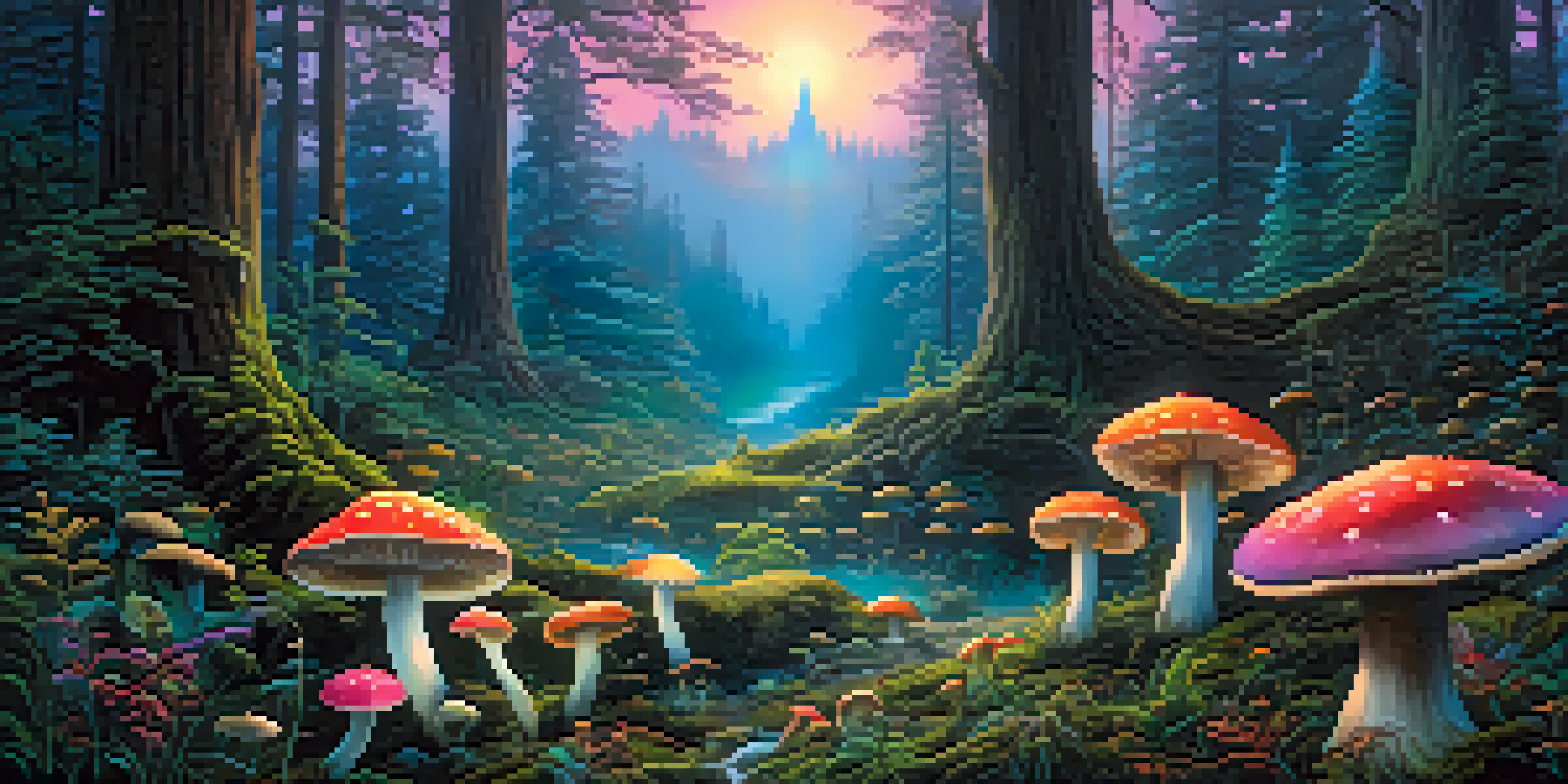The Role of Neurotransmitters in Entheogen-Induced Visions

Understanding Neurotransmitters and Their Functions
Neurotransmitters are chemical messengers in the brain that play a crucial role in transmitting signals between neurons. They influence everything from mood to perception, making them essential for understanding human experience. Different neurotransmitters have unique functions; for instance, serotonin is often linked to feelings of happiness, while dopamine is associated with reward and pleasure.
The mind is everything. What you think you become.
When we delve into the world of entheogens, which are substances that alter consciousness, neurotransmitters become even more significant. These compounds can drastically change our brain chemistry, leading to altered states of consciousness. Understanding how these neurotransmitters work helps us grasp why entheogens can evoke such powerful visions and experiences.
In essence, neurotransmitters are like the conductors of an orchestra, coordinating the symphony of thoughts and feelings that arise during altered states. This coordination is especially vital when exploring the profound effects of entheogens on our perception of reality.
The Link Between Entheogens and Neurotransmitter Release
Entheogens, such as psilocybin or ayahuasca, interact with neurotransmitter systems, primarily serotonin and dopamine. When consumed, these substances can mimic or enhance the effects of naturally occurring neurotransmitters, leading to intense emotional and sensory experiences. For example, psilocybin binds to serotonin receptors, which can result in vivid visual and auditory hallucinations.

This interaction doesn't just amplify existing neurotransmitter functions; it can also alter the way our brain networks communicate. By disrupting normal patterns, entheogens can create entirely new neural pathways. This is akin to taking a different route through a familiar landscape, revealing parts of the terrain that were previously hidden from view.
Neurotransmitters Shape Experience
Neurotransmitters like serotonin and dopamine are key players in influencing mood, perception, and the powerful experiences evoked by entheogens.
As a result, the visions experienced during entheogen use can feel incredibly profound and enlightening. They may provide insights or revelations that feel both personal and universal, prompting users to reflect deeply on their lives and beliefs.
Types of Neurotransmitters Involved in Vision
Several key neurotransmitters play a role in the visions induced by entheogens. Serotonin, as mentioned earlier, is a major player, but others like norepinephrine and glutamate are also involved. Norepinephrine can heighten alertness and arousal, while glutamate is crucial for synaptic plasticity, affecting learning and memory.
Neuroscience is the new psychology; it is the science of consciousness.
The interplay of these neurotransmitters is intricate, creating a rich tapestry of experiences during altered states. When someone uses an entheogen, the balance of these chemicals can shift dramatically, influencing how they perceive visual stimuli. This shift can lead to experiences that feel transcendent or deeply meaningful.
Imagine attending a concert where the music is so powerful it transforms the entire venue. Similarly, the surge of neurotransmitters can elevate ordinary sights into extraordinary visions, allowing users to connect with their inner selves or the universe at large.
The Role of the Default Mode Network in Vision
The Default Mode Network (DMN) is a group of brain regions that are active when we are at rest and not focused on the external environment. Under normal circumstances, the DMN is involved in self-referential thought, such as daydreaming and recalling memories. However, during entheogen use, the activity in the DMN can be significantly altered, leading to unique visionary experiences.
This alteration can result in a decreased sense of ego and heightened connectivity between different brain regions. As the DMN quiets down, users might experience a sense of unity with their surroundings, enhancing visual and emotional experiences. This phenomenon is often described as losing one's sense of self and merging with the universe.
Context Influences Vision Effects
The setting and mindset during entheogen use significantly affect neurotransmitter responses, shaping the nature of the visions experienced.
By understanding the DMN's role in vision during entheogen use, we can appreciate how these substances facilitate profound experiences. It's like switching from a single channel on a television to a multi-dimensional experience, where each image is interconnected and rich with meaning.
How Context Influences Neurotransmitter Responses
The context in which entheogens are taken can significantly influence the neurotransmitter response and subsequent visions. Factors like setting, mindset, and even the company of others can shape the experience. For example, a serene environment may enhance feelings of peace and connection, while a chaotic setting could lead to anxiety or confusion.
This highlights the importance of creating a supportive environment for those exploring entheogens. Just as a garden flourishes with the right conditions, so too do our visions thrive in a positive context. By understanding how context affects our brain chemistry, we can better prepare for the journey ahead.
Ultimately, the interplay of neurotransmitters and context can turn a simple experience into a transformative one, allowing users to explore their consciousness in profound ways.
Potential Therapeutic Applications of Entheogens
Recent research has begun to explore the therapeutic potential of entheogens, particularly in treating mental health conditions like depression and PTSD. By understanding how neurotransmitters are influenced during these experiences, scientists are uncovering new pathways for healing. For instance, the serotonin boost from psilocybin has shown promise in alleviating symptoms of depression.
These therapeutic applications hinge on the understanding that altered states of consciousness can lead to breakthroughs in emotional processing. Just as a therapist helps a client reframe their thoughts, entheogens can facilitate profound shifts in perspective, allowing individuals to confront and integrate difficult emotions.
Therapeutic Potential of Entheogens
Research is uncovering how entheogens can provide therapeutic benefits for mental health conditions by altering neurotransmitter activity.
As we continue to study the intersection of neurotransmitters, entheogens, and therapy, we may find innovative ways to harness these experiences for healing. It's a fascinating frontier in mental health, merging ancient practices with modern science.
Conclusion: Embracing the Complexity of Experiences
In conclusion, the role of neurotransmitters in entheogen-induced visions is a complex tapestry woven from biology, context, and personal experience. Understanding this interplay not only enriches our knowledge of the brain but also deepens our appreciation for the transformative power of these substances. Each vision is a unique narrative shaped by the intricate workings of our neurotransmitters.
As more people explore entheogens, it's crucial to approach these experiences with respect and awareness of their potential. By recognizing the profound effects these substances can have on our brain chemistry, we can navigate our journeys with intention and mindfulness.

Ultimately, the relationship between neurotransmitters and entheogen-induced visions invites us to embrace the mystery of consciousness. It encourages us to explore the depths of our minds and discover the beauty that lies within.